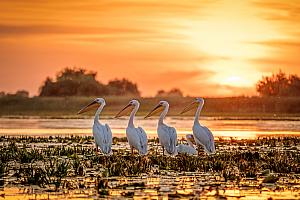Romania Photo of the Day by Dreamstime: The wild horses of the Danube Delta

The Romania Photo of the Day created in partnership with stock photo provider Dreamstime aims to highlight the best of Romania. From stunning landscapes and popular tourist destinations and landmarks to people, traditions, and food, this series helps you discover Romania one photo at a time. This week, we put the focus on the Danube Delta and Danube landscapes.
Around 4000 wild horses live in complete freedom in the Danube Delta, according to the nature documentary project Untamed Romania. (Photo source - click on the number to get to the original file: 24634595 © Pruteanu Alex | Dreamstime.com)
Each herd consists of several dozen horses, most of which can be found in Letea, with the rest living in Caraorman, on Sahalin Island, and on other delta ridges.
It is said that during the Communist period, these horses were used in agricultural production and that they were let loose by the locals after the Revolution due to a lack of resources for food and care. Some of them might have been released even earlier, during the 1980s, when a viral disease broke out on one of the horse farms in Sfântu Gheorghe. Others still may have been abandoned when their owners moved into cities.
The horses that withstood the drought and heat of summer, and the bitter cold of winter, became wild over time. They acquired a herd instinct, became more resilient, and began to use the harsh steppe vegetation as food.
According to Untamed Romania, the fate of these unusual horses remains a controversial issue because their habitat is part of the most protected natural area in Romania: Letea Forest. Established in 1938, the forest is the oldest nature reserve in Romania.
It is located between the Sulina and Chilia branches of the Danube in the Delta, and covers an area of nearly 7000 acres.
This forest was the initial foundation of the Danube Delta Biosphere Reserve, which has been declared a World Heritage Site.
Animal lovers support letting the horses stay in the delta. However, botanists point to the negative effects that the horses can have on the flora of the Letea Forest, which they eat, thus endangering the regeneration of the forest.
Currently, the horses in Letea are fenced in, so as to protect the forest, but this has not been a good solution as the summer heatwave recently dried up their watering holes, leaving them without any water sources.













